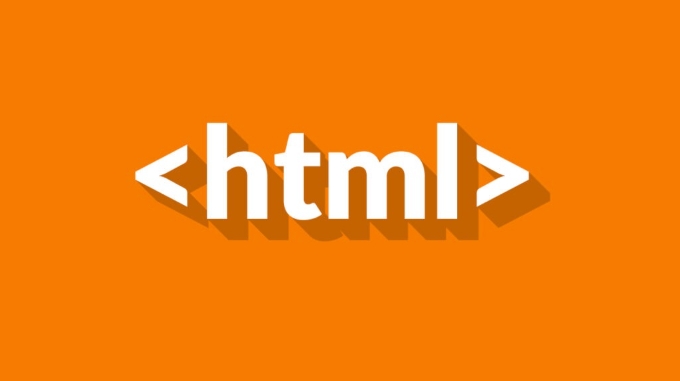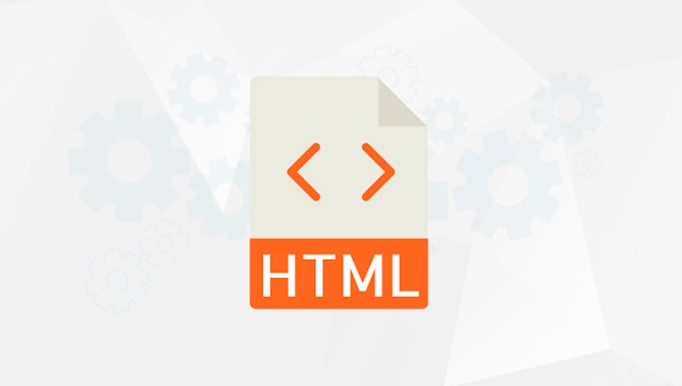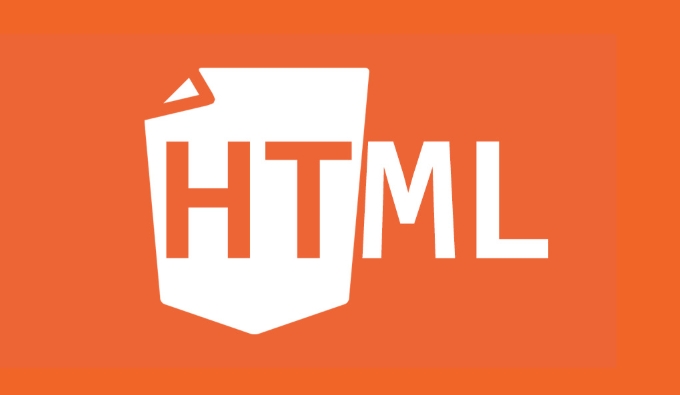html`option`值'和`label`属性
value是表单提交时发送的数据,label是用户在下拉菜单中看到的文本。若未指定label,浏览器会使用option的文本内容;使用label可实现显示文本与提交值分离,适用于多语言、简洁值或辅助技术场景;现代浏览器大多支持label,但兼容性仍需注意;value决定提交数据,务必确保其符合后端预期;实用建议包括:根据需要使用label提升用户体验、动态生成选项时检查value和label、避免重复内容,并考虑无障碍支持。

When working with HTML dropdown menus using the <select></select> element, you often use <option></option> tags inside it. Two attributes that come into play here are value and label. Understanding how they work can help avoid confusion and ensure your form behaves as expected.

What’s the Difference Between value and label?
The short version:
- The
valueis what gets sent when the form is submitted. - The
labelis a human-readable name shown in the dropdown menu.
If you don’t specify a label, browsers will fall back to using the text content of the <option></option>. But sometimes, especially in internationalized apps or when values need to be compact, having a separate label makes sense.

Here’s an example:
<option label="United States" value="US">USA</option>
In this case, the user sees “United States” in the dropdown (if the browser supports label), but when the form is submitted, it sends “US”.

When Should You Use label?
You might not always need it. In most basic forms, just setting the text and value is enough. However, there are situations where label becomes useful:
- When the visible text needs to be longer or more descriptive than the actual value.
- If you're supporting multiple languages and want to keep values consistent while changing displayed labels.
- When working with assistive technologies that may benefit from clearer labels.
For example:
<option label="California - CA" value="CA">CA</option>
This way, users get context without making the selected text too short to understand.
Keep in mind: not all browsers consistently display the label attribute. Most modern ones do, but if compatibility matters, test across environments or consider using JavaScript-based select replacements.
How Does value Work in Forms?
The value attribute is essential because it determines what data gets sent when the form is submitted. Let's say you have:
<select name="state"> <option value="CA">California</option> <option value="NY">New York</option> </select>
If a user picks "California", the form will submit state=CA.
Even if you set a label, the value still controls what’s submitted. So it's important to make sure the value matches whatever your backend expects — like codes, IDs, or standardized strings.
A common mistake is forgetting that the value isn't always visible. If someone inspects the code, they’ll see both the text and value, but during normal use, only the label (or text) appears in the dropdown.
Practical Tips for Using value and label
Here are a few things to keep in mind when building your options:
- Use
labelwhen you want better UX without changing the actual value. - Always double-check the
valuebefore submitting — especially when dynamically generating options. - Avoid duplication between
labeland text unless you have a reason. - Consider accessibility — screen readers may read either the label or the text content depending on support.
And if you're generating these options with JavaScript or templates, make sure to format them correctly:
const option = document.createElement('option');
option.value = 'US';
option.label = 'United States';
option.text = 'USA';That should cover most cases.
基本上就这些。
以上是html`option`值'和`label`属性的详细内容。更多信息请关注PHP中文网其他相关文章!

热AI工具

Undress AI Tool
免费脱衣服图片

Undresser.AI Undress
人工智能驱动的应用程序,用于创建逼真的裸体照片

AI Clothes Remover
用于从照片中去除衣服的在线人工智能工具。

Clothoff.io
AI脱衣机

Video Face Swap
使用我们完全免费的人工智能换脸工具轻松在任何视频中换脸!

热门文章

热工具

记事本++7.3.1
好用且免费的代码编辑器

SublimeText3汉化版
中文版,非常好用

禅工作室 13.0.1
功能强大的PHP集成开发环境

Dreamweaver CS6
视觉化网页开发工具

SublimeText3 Mac版
神级代码编辑软件(SublimeText3)
 '`vs.` `在html中
Jul 19, 2025 am 12:41 AM
'`vs.` `在html中
Jul 19, 2025 am 12:41 AM
是块级元素,用于划分大块内容区域;是内联元素,适合包裹小段文字或内容片段。具体区别如下:1.独占一行,可设置宽高、内外边距,常用于布局结构如头部、侧边栏等;2.不换行,仅占据内容宽度,用于局部样式控制如变色、加粗等;3.使用场景上,适用于整体区域的排版与结构组织,而用于不影响整体布局的小范围样式调整;4.嵌套时,可包含任何元素,而内部不应嵌套块级元素。
 初学者的基本HTML标签
Jul 27, 2025 am 03:45 AM
初学者的基本HTML标签
Jul 27, 2025 am 03:45 AM
要快速入门HTML,只需掌握几个基础标签即可搭建网页骨架。1.页面结构必备、和,其中是根元素,包含元信息,是内容展示区域。2.标题使用到,级别越高数字越小,正文用标签分段,避免跳级使用。3.链接使用标签并配合href属性,图片使用标签并包含src和alt属性。4.列表分为无序列表和有序列表,每个条目用表示且必须嵌套在列表中。5.初学者不必强记所有标签,边写边查更高效,掌握结构、文本、链接、图片和列表即可制作基础网页。
 如何在HTML中添加图像?
Jul 15, 2025 am 03:03 AM
如何在HTML中添加图像?
Jul 15, 2025 am 03:03 AM
在HTML中添加图片的关键是使用img标签并正确设置属性。首先,必须使用标签并设置src属性指定图片路径,其次建议添加alt属性提供替代文本;路径可以是相对路径或绝对路径,需注意大小写、格式支持及服务器配置;此外可通过CSS控制图片样式以增强响应性与美观度。
 影子dom概念和HTML集成
Jul 24, 2025 am 01:39 AM
影子dom概念和HTML集成
Jul 24, 2025 am 01:39 AM
ShadowDOM是Web组件技术中用于创建隔离DOM子树的技术。1.它允许在普通HTML元素上挂载独立的DOM结构,拥有自己的样式和行为,不与主文档互相影响;2.通过JavaScript创建,例如使用attachShadow方法并设置mode为open;3.结合HTML使用时具备结构清晰、样式隔离和内容投影(slot)三大特点;4.注意事项包括调试复杂、样式作用域控制、性能开销及框架兼容性问题。总之,ShadowDOM提供了原生封装能力,适用于构建可复用且不污染全局的UI组件。
 使用HTML`链接rel =' preload”```''
Jul 19, 2025 am 12:54 AM
使用HTML`链接rel =' preload”```''
Jul 19, 2025 am 12:54 AM
linkrel="preload"是一种优化页面加载性能的技术,用于提前加载关键资源。其核心用途在于优先加载对首屏渲染至关重要的资源,如字体、关键CSS/JS和首屏图片。使用时需注意:1.正确设置as属性以指定资源类型;2.避免滥用,防止带宽占用过高;3.确保资源会被实际使用,否则造成请求浪费;4.对跨域资源添加crossorigin属性。错误写法如缺少as属性会导致预加载无效。合理使用可提升页面加载效率,反之则可能适得其反。
 HTML及其使用中可用的不同类型的列表是什么?
Jul 15, 2025 am 02:59 AM
HTML及其使用中可用的不同类型的列表是什么?
Jul 15, 2025 am 02:59 AM
HTML提供三种列表类型以结构化内容。1.无序列表()用于无顺序要求的条目,如功能列表或食材;2.有序列表()用于有顺序要求的内容,如步骤说明,支持多种编号格式;3.描述列表(、、)用于术语与描述配对,如词典或产品规格;此外,还支持嵌套列表,可在主条目下添加子列表以组织复杂信息,从而提升页面可读性与可访问性。
 您可以在另一个标签中放置一个标签吗?
Jul 27, 2025 am 04:15 AM
您可以在另一个标签中放置一个标签吗?
Jul 27, 2025 am 04:15 AM
❌Youcannotnesttagsinsideanothertagbecauseit’sinvalidHTML;browsersautomaticallyclosethefirstbeforeopeningthenext,resultinginseparateparagraphs.✅Instead,useinlineelementslike,,orforstylingwithinaparagraph,orblockcontainerslikeortogroupmultipleparagraph
 html'样式”标签:内联与内部CSS
Jul 26, 2025 am 07:23 AM
html'样式”标签:内联与内部CSS
Jul 26, 2025 am 07:23 AM
样式放置方式需根据场景选择。1.Inline适合单元素临时修改或JS动态控制,如按钮颜色随操作变化;2.内部CSS适合页面少、结构简单项目,便于集中管理样式,如登录页基础样式设置;3.优先考虑复用性、维护性及性能,大项目拆分外链CSS文件更优。







